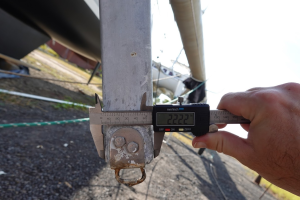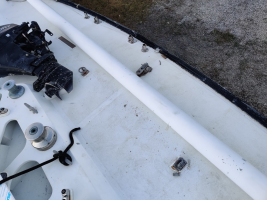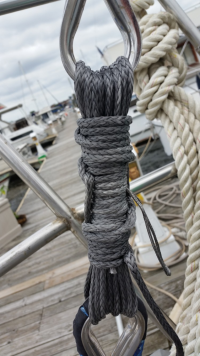I'm still at the beginning of this adventure. I figured I'd share where I'm at and try to get some thoughts down.
Right now the mast is down and I've measured the rigging as well as worked on plans to make some changes.
One challenge with the 46 is that is used internal rigging termination - that is, the stays actually connect to an internal stainless steel saddle.
To remove the things, I have to disconnect the mast splice and pull the mast apart. The top of the mast is welded and the bottom has an internal shield to send water out of the mast instead of down inside it.
Here's what I mean: (My mast)
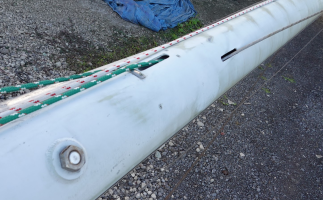
You can see the stay going into the mast. One of the saddles below hangs over that 1" bolt.
These are the saddles that live inside the mast: (Photo from Guy's Aiki, mine are still in the thing)
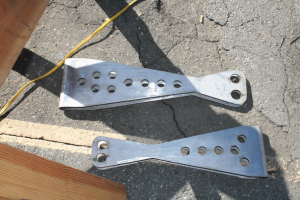
Right now, I've started taking the splice apart - I've broken three different impact bits, but got started with the screws at least.
Next up is how to re-terminate the rigging.
After talking to Colligo several times, we think the easiest option is to use a longer bolt with a sleeve in the 1 inch bolt holes. (The old saddles provided the internal sleeve before)
Colligo makes Cheeky Tangs:
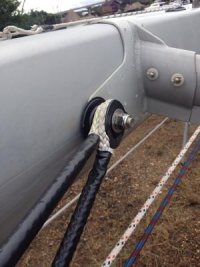
They are a very clean looking option.
Alternatively I could have some larger version of these made up:

I'd want something larger that the 5/16" pin this version uses. Which is why I think I'd have to have them fabricated.
The next issue is the Spars.
On the uppers, we have a couple of guide pins.

These can probably be re-rused, but I'll probably make up something better with a smooth guide surface and tie points for lashings.
The lower spars had a sort of pivot toggle that was attached using a large pin fitting.
This originally terminated the upper and mid stay, with a final say running to the deck.
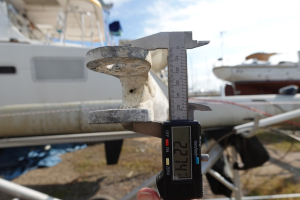
For these, I'm going to make up a sort of modified double pully to allow a continuous run of both the upper and mid stays to extend fully to the deck.
John at Colligo tells me that often they just use a couple of terminators and modify them to fit.
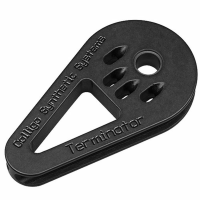
Grab a pair of these, then cut the end off so they fit into the end of the spar and use the old pin to hold them in place.
Finally we get to the deck terminations.
The e46 has six total 'chainplates' - but really only two actual chainplates.
The forward and mid points are part of the internal rib cage of the boat.
The aft points are actual chainplates that bolt to the bulkheads inside the cabin.

These are the ribs on Madeye. The middle does have some reinforcements already.
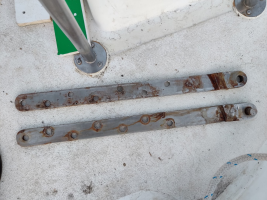
The chainplates I pulled. They actually don't look horrible up close but I'm going to replace them since they are original.
Continued since I've used all my images for this post!
Right now the mast is down and I've measured the rigging as well as worked on plans to make some changes.
One challenge with the 46 is that is used internal rigging termination - that is, the stays actually connect to an internal stainless steel saddle.
To remove the things, I have to disconnect the mast splice and pull the mast apart. The top of the mast is welded and the bottom has an internal shield to send water out of the mast instead of down inside it.
Here's what I mean: (My mast)

You can see the stay going into the mast. One of the saddles below hangs over that 1" bolt.
These are the saddles that live inside the mast: (Photo from Guy's Aiki, mine are still in the thing)

Right now, I've started taking the splice apart - I've broken three different impact bits, but got started with the screws at least.
Next up is how to re-terminate the rigging.
After talking to Colligo several times, we think the easiest option is to use a longer bolt with a sleeve in the 1 inch bolt holes. (The old saddles provided the internal sleeve before)
Colligo makes Cheeky Tangs:

They are a very clean looking option.
Alternatively I could have some larger version of these made up:

I'd want something larger that the 5/16" pin this version uses. Which is why I think I'd have to have them fabricated.
The next issue is the Spars.
On the uppers, we have a couple of guide pins.

These can probably be re-rused, but I'll probably make up something better with a smooth guide surface and tie points for lashings.
The lower spars had a sort of pivot toggle that was attached using a large pin fitting.
This originally terminated the upper and mid stay, with a final say running to the deck.

For these, I'm going to make up a sort of modified double pully to allow a continuous run of both the upper and mid stays to extend fully to the deck.
John at Colligo tells me that often they just use a couple of terminators and modify them to fit.

Grab a pair of these, then cut the end off so they fit into the end of the spar and use the old pin to hold them in place.
Finally we get to the deck terminations.
The e46 has six total 'chainplates' - but really only two actual chainplates.
The forward and mid points are part of the internal rib cage of the boat.
The aft points are actual chainplates that bolt to the bulkheads inside the cabin.

These are the ribs on Madeye. The middle does have some reinforcements already.

The chainplates I pulled. They actually don't look horrible up close but I'm going to replace them since they are original.
Continued since I've used all my images for this post!

